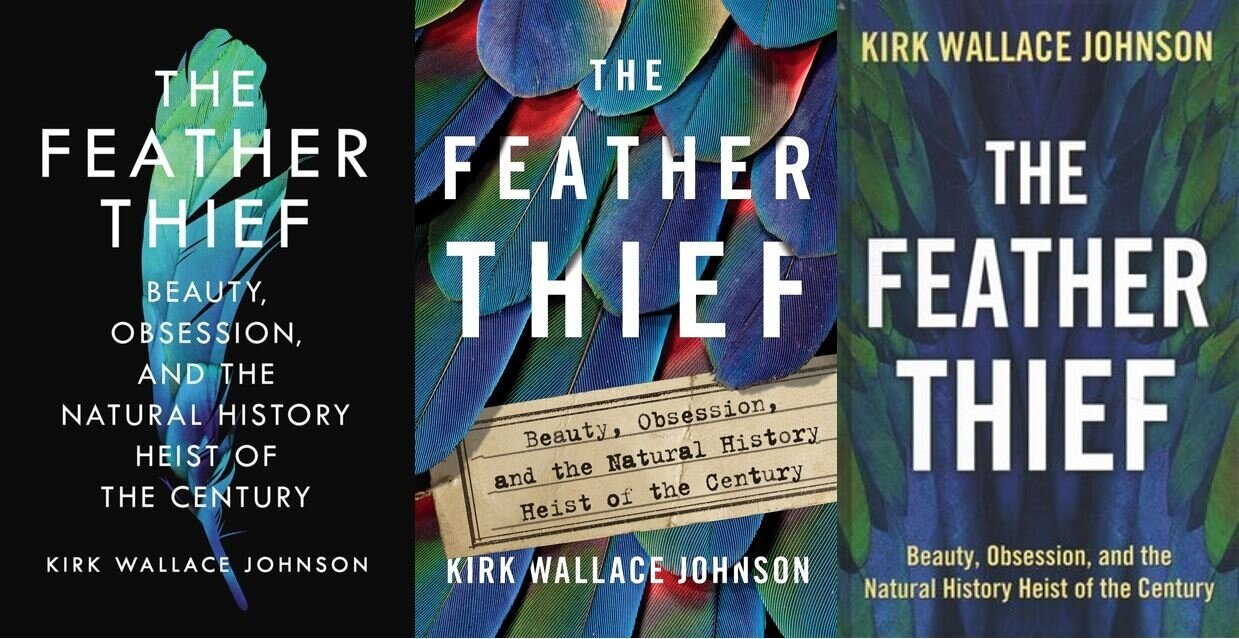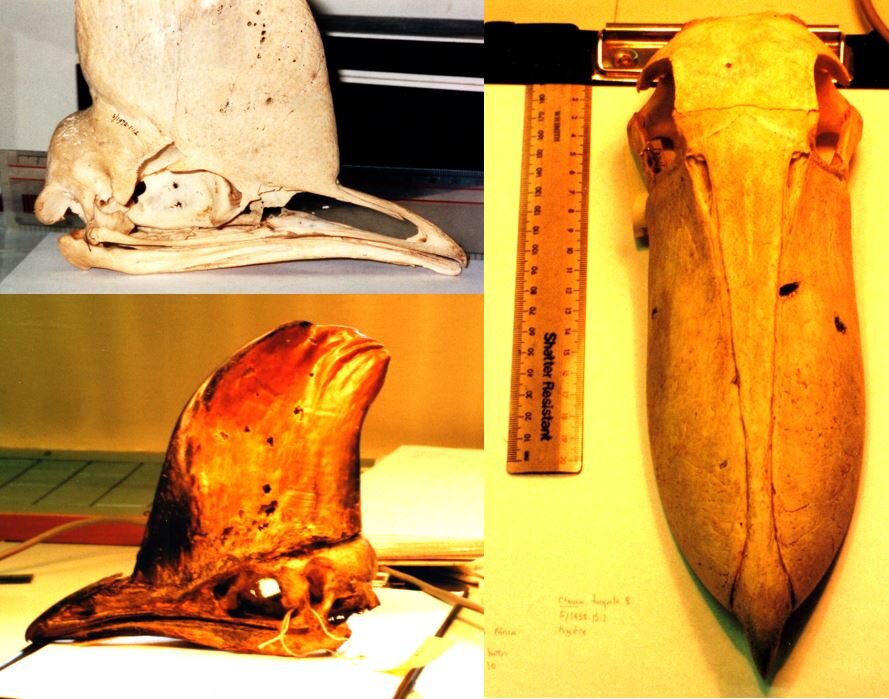A (belated) review of one of the saddest and most remarkable tales in modern museum history…
Caption: several different covers seem to exist for The Feather Thief. I own the one at furthest left.
You don’t have to be a zoologist or a technical expert of any sort to appreciate that the remains of animals kept in museums might be worth something. Surely, there have been all manner of occasions where people have tried – even succeeded – in stealing such things? Yes, there have indeed. Theft from museums is a global issue and some of the stories – involving bird eggs, rhino horns and dinosaur fossils – are amazing in their audacity, extravagance, and nerve. For those of us interested in the natural world and its preservation and study they are, of course, also saddening, frustrating and even sickening since they overwhelmingly centre around the plundering of items in the public trust for selfish personal or financial gain.
Among the most unbelievable of such episodes is the 2009 event in which 21-year-old music student and obsessive feather collector Edwin Rist broke into the world-famous ornithological collections of the UK’s Natural History Museum and stole 299 bird specimens. I should make it clear that these were the rather flattened, prepared skins which are kept in storage drawers in the museum research collections, not mounted, life-like specimens of the sort displayed in public galleries.
After breaking in through a window at night, piling the birds into a suitcase and taking them (via train) back to his London flat, Rist planned either to break the specimens to bits and use them in the creation of artisan, faux-antique fishing flies, or to sell them on to other interested parties in the arcane fly-tying world of which he was a beloved part. That’s right: museum specimens were stolen so that they could be ripped to shreds and turned into fishing flies.
Caption: the Natural History Museum at Tring, formerly the Walter Rothschild Zoological Museum at Tring, Hertfordshire - home of the Natural History Museum ornithological collection - may or may not be in keeping with your view of what a provincial English museum is like. Image: Ian Petticrew, CC BY-SA 2.0 (original here).
An important part of the Rist bird theft story (not obvious to those outside the museum world or ornithological research community) is that the ornithological collection he plundered is not in London nor at all close to the famous building in South Kensington, but instead at the Walter Rothschild Zoological Museum in Tring, Hertfordshire. Tring – located about 50 km to the north-west of London – is a relatively small town with green surrounds, its main claim to fame being its association with Walter Rothschild and his zoological collection. This might help to put the theft, and Rist’s entire, successful plan into context.
Caption: part of the interior of the Natural History Museum at Tring as it looked in February 2003. As you can see, very much an ‘old school’ museum. This photo was taken back in the days of physical photos. Image: Darren Naish.
While this remarkable story did get some media coverage back when it happened, there wasn’t much, and I can forgive you if you missed it. It’s thus (and I say the following with awareness of how painful the story is, read on) very welcome that a handsome and highly readable popular book has been written about it. That book is Kirk Wallace Johnson’s The Feather Thief, published in 2018 (as usual, apologies for my tardiness. Better late than never).
As a zoological researcher and scientist who’s spent reasonable time in the collections at Tring, I’m one of the many who feels personally affected by this event. An insider knowledge of what the collections consist of, how they work and what the entire facility is like is also helpful in appreciating the story Johnson relates, in particular because opinions promoted by some of the characters Johnson interviewed – people belonging to the community of elite fly-tiers of which Rist is or was a part – smell like the bullshit they are. I’ll elaborate on that point in a moment. Enough preamble, on to the book.
Caption: a few of the NHM Tring specimens (from the osteological section, rather than the skin section) which I’ve had reason to examine in my own research. Museums have records of every single specimen; for animals like birds, they’re documented in the published literature as well as in the physical paper files and digital files maintained by the museum curators. Researchers who specialise on the groups concerned often ‘know’ individual specimens. Images: Darren Naish.
Kirk Johnson is a good guy. I like him. His story before writing about the theft of museum specimens involves life in the US Agency for International Development, deployment in Iraq, and work on the rehoming of Iraqi refugees; his humanitarian interests and hard work in those areas is discussed, where appropriate, here and there in the book. This helps, I feel, ground things with a moral centre which never leaves any doubt that Johnson is honestly interested in doing the best, or right, thing. Which I feel is crucial, since there are occasions in the book where he reports discussions with people – Rist among them – who imply that theft from museums is ok and should even be encouraged.
The birds that Rist stole included cotingas, quetzals and birds-of-paradise. At least some were from the historical collection famously accrued by Alfred Russel Wallace during his 19th century fieldwork in New Guinea and elsewhere, and all, of course, were part of the enormous, globally significant collection amassed by Walter Rothschild. The first 68 pages of Johnson’s book recount this backstory – Wallace’s work on biogeography, Rothschild’s obsessive collecting, his family background, his cassowaries, the blackmailing incident – in order that we appreciate the historical context of the bird specimens. I get that this is needed for readers unfamiliar with ornithological and Tring history but…. I found it such a chore to get through that I become thoroughly dispirited and bored, and I put the book down and left it for months. As much as I hate sounding like some kind of snobbishly arrogant, well-read bastard, this reflects the fact (extremely common if you read a lot of material relevant to your specialist area) that specialist books so often go over the same ground before getting to the new stuff.
Caption: at left, Alfred R. Wallace in later life, a photo from 1895; at right, images showing Walter Rothschild, plus the cover of the most valuable book that discusses Rothschild and his life. Images in public domain.
I’m glad, however, that I did pick the book up again. You’ll need to read it yourself to learn the full details of the case’s intricacies and the depth of Johnson’s investigation, but suffice to say that he gets to the bottom of things as best as anyone could. Rist left a hilariously inept paper-trail demonstrating his guilt, involving ebay listings, a well-recorded history of deep involvement in the fly-tying world and even a file on his computer titled ‘plan for museum invasion’.
The feather-tiers don’t come out of this at all well, closing ranks and even deliberately stifling and deleting communication so that discussion about the Rist case was (and is) minimised or expunged. Johnson demonstrates that some of them are guilty of buying stolen material from Rist. I might have been neutral about artisan fly feathers and fly-tying before reading Johnson’s book (my only previous experience is from Thor Hanson’s 2011 book Feathers, which I reviewed here), but my feelings toward it are certainly coloured now.
Caption: two of the birds involved in the theft. At left, Red-ruffed fruitcrow Pyroderus scutatus. At right, Spangled cotinga Cotinga cayana. Images: Nicolas Huet, in the public domain; Greg Hume, CC BY-SA 3.0 (original here).
Rubbing salt in the wound is that at least some of the fly-tiers that Johnson spoke to – Rist included – seem to think that museum collections like those of Tring run something like badly organised sock drawers, and that Rist and his buddies might be cast as heroes for rescuing unloved socks and giving them a new lease of life. This is such an insult to everything that museum collections stand for – especially priceless, world-class ones like that at Tring – that I’m not sure where to start.
It was, on that note, refreshing to see Johnson report the very honest opinion of ornithologist Richard Prum, a specialist on the birds affected by the theft. Prum says a lot of negative things about artisan fly-tiers which I found myself agreeing with (Johnson 2018, pp. 199-200), summarised thusly by Johnson “Edwin [Rist] and the feather underground were a bunch of historical fetishists, practising a ‘candy-ass, ridiculous, parasitic activity’ that Prum would be glad to see go extinct” (Johnson 2018, p. 200). Prum, it turns out, was performing his own amateur sleuthing on the case and was thoughtful enough to compile and save some mass of relevant online documentation before it was deleted, all of which proved useful to Johnson’s investigation. I should also note the amateur detective work (unknown to Johnson, so far as I can tell) performed by Katrina van Grouw (best known for her books The Unfeathered Bird of 2013 and 2018’s Unnatural Selection, but based at Tring when the theft occurred) also uncovered online proof of the illegal sale of the specimens.
Caption: specimens of the sort that Rist stole, shown here as stored in the museum collections. Note the labels which contain important locality and date information. Image: (c) Natural History Museum, London (original here).
How is it that Rist was never truly admonished for this remarkable, costly, destructive theft? In recounting the 2011 court case, Johnson describes how the judge decided – seemingly on the basis of his own incredulity about Rist’s actions – that Rist must surely suffer from Asperger’s syndrome, this being the catalyst which inspired the ‘Asperger’s defence’. As Rist himself later expressed in an interview with Johnson, the court fell for this hook, line and sinker, and they shouldn’t have. It was a travesty.
The Feather Thief is very well written, the pace is engaging, and the story is fascinating. One detail I tried really hard to overlook but couldn’t is Johnson’s very peculiar and constantly present reference to the ornithological collections at Tring as ‘the Tring’, as if ‘Tring’ is synonymous with the name of the museum or something. It isn’t, and this is a bit like referring to, say, the Sydney Opera House as ‘the Sydney’. It’s just wrong.
Caption: here’s evidence of what Rist did with the birds he stole. These ziploc bags - containing quetzal feathers - were recovered from Rist’s apartment. Image: (c) Kirk Johnson The Feather Thief, from here.
Like it or not, the Edwin Rist episode is now an important, indeed instructional, part of ornithological and museum history. Maybe it’s not easy or even possible to work out where the next ‘threat’ might come from, but those interested in the history of bird collections, in natural history collections in general, or – more specifically – in the fate of trogons, cotingas, birds of paradise and other famous exotic birds should certainly read this book and have it to hand for reference. Indeed, the book is (to my knowledge) the best compilation and (almost certainly) most thoroughly complete account of what happened.
Kirk Wallace Johnson, 2018. The Feather Thief: Beauty, Obsession, and the Natural History Heist of the Century. Hutchinson, London. pp. 297. ISBN 978-1-786-33013-0. Hardback. Here from the publishers, here from amazon, here from amazon.co.uk.
Caption: my copy.
For previous TetZoo articles linked in some way to this one (because they’re on the relevant groups of birds or on matters of ornithology somehow connected to what’s discussed here), see…













